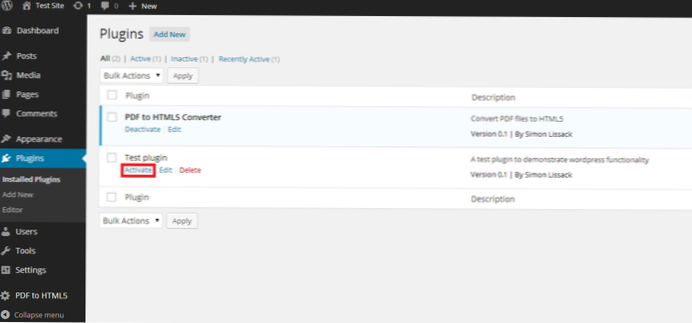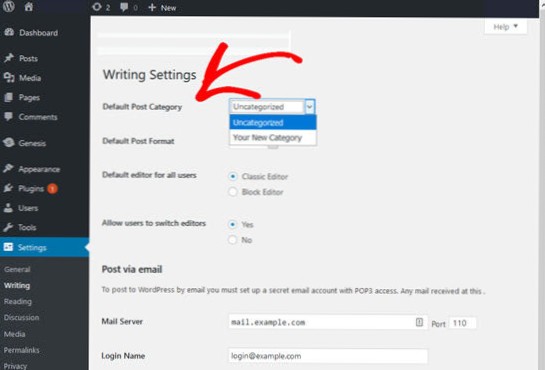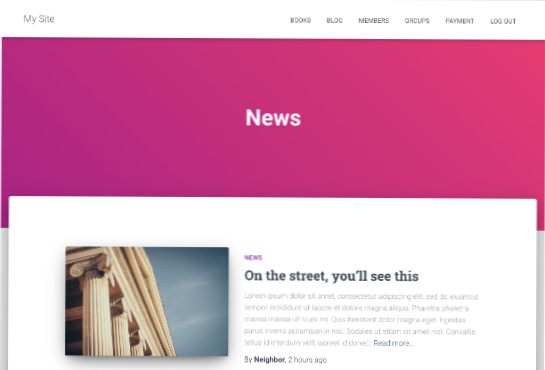- How do I create a simple WordPress plugin?
- How do I customize my WordPress admin interface?
- How can I create my own plugin?
- How do I save custom settings for my WordPress Plugin?
- Do plugins slow down WordPress?
- How do I access WooCommerce Admin?
- How do I customize my WooCommerce backend?
- How do I customize my Django admin?
- What is custom plugin?
- What plugin means?
- How do I create a custom post in WordPress without plugins?
How do I create a simple WordPress plugin?
Create your first plugin in five simple steps
- FTP into your site. ...
- Navigate to the WordPress plugins folder. ...
- Create a new folder for your plugin. ...
- Create the main PHP file for your plugin. ...
- Setup your plugin's information.
How do I customize my WordPress admin interface?
After installing and activating the plugin, make sure to set the user roles you'll be customizing for. If it's for your own use, select just the Administrator role. If it's for other users, choose suitable roles. Next, go to WP Admin UI Customize > Admin Bar to modify the admin bar menu items.
How can I create my own plugin?
To create a plugin, all you need to do is create a folder and then create a single file with one line of content. Navigate to the wp-content/plugins folder, and create a new folder named awesomeplugin . Inside this new folder, create a file named awesomeplugin.
How do I save custom settings for my WordPress Plugin?
How to save custom settings for your WordPress plugin
- Register the menu page and/or a sub-menu page in the WP Dashboard.
- Add a settings section under the sub-menu page.
- Register settings and settings fields under the settings section.
- Add settings fields for each registered setting and provide a callback that renders the html for each field.
Do plugins slow down WordPress?
Yes, more plugins will add more code that a browser has to load, which can slow it down. ... Since plugins are basically a way of adding code without having to write it yourself, telling new WordPress folks to run as few plugins as possible is great advice.
How do I access WooCommerce Admin?
WooCommerce Admin is a new JavaScript-driven interface for managing your store.
...
Automatic installation
- Log in to your WordPress dashboard.
- Go to: Plugins > Add New.
- Enter “WooCommerce Admin” in the Search field, and view details about its point release, the rating and description.
- Select “Install Now” when you're ready.
How do I customize my WooCommerce backend?
How to Customize the WordPress Backend Manually
- Customize the Login Page. ...
- Make Use of WordPress User Roles. ...
- Hide Or Eliminate Menu Items. ...
- Customize Screen Options. ...
- Add Custom Widgets to the WordPress Dashboard. ...
- Disable Theme and Plugin Editor. ...
- Edit the Dashboard Footer. ...
- Custom Login Page Customizer.
How do I customize my Django admin?
Customize Django Admin Interface
- Change model name: If you want to change name of model which is States here so open model.py file and add verbose_name attribute in meta section. ...
- By default django admin shows only object name in listing. ...
- By default there is only one option which is delete option. ...
- Disable Delete option: ...
- Remove Add option:
What is custom plugin?
What is a custom functionality plugin? ... A custom functionality plugin is simply a different way to store functions for your site. By putting them in a plugin instead of functions. php, you can change child themes without losing those pieces of code that make your site work the way you want. Editing functions.
What plugin means?
Plug-in, also called add-on or extension, computer software that adds new functions to a host program without altering the host program itself. ... Widely used in digital audio, video, and Web browsing, plug-ins enable programmers to update a host program while keeping the user within the program's environment.
How do I create a custom post in WordPress without plugins?
How to Create Custom Post Types In WordPress Without Plugin
- Step 1: Add custom post type function in functions. ...
- Step 1: Go to your theme folder and duplicate archive. ...
- Step 2: Now all your custom posts with taxonomy “leagues” will use archive-leagues. ...
- Step 1: Go to your theme folder and duplicate single. ...
- Step 2: Now all the custom posts will use single-games.
 Usbforwindows
Usbforwindows



